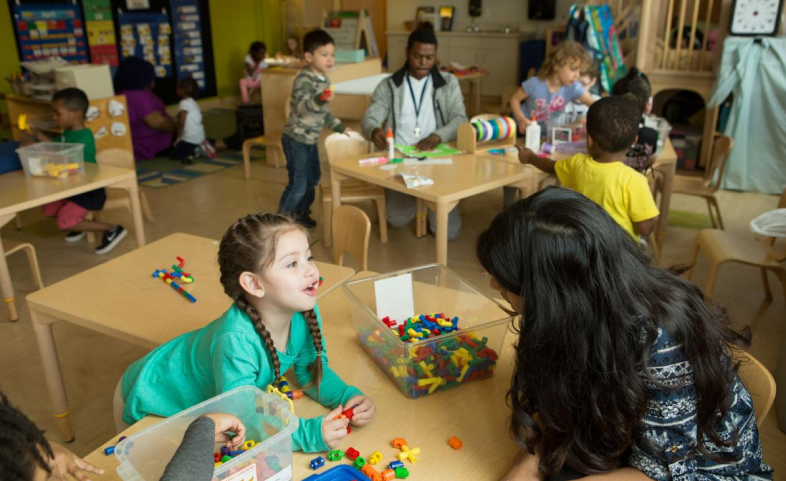Patricia Twymon set her jaw and spoke slowly and firmly.
“The misperception is that I am a babysitter,” Twymon told a room full of education journalists. “I am not a babysitter. I am an educator, I am a professional, and I should be treated as such.”
Twymon, a child care provider in the Chicago area, shared her views and experiences during a recent Education Writers Association seminar on early learning. The discussion addressed the challenges faced by child care providers and the ramifications of those challenges for early learning.
Numerous studies have shown that a child’s academic success in school is affected, to a large extent, by their experiences before they enter a kindergarten classroom. Gaps in school readiness are firmly established by age five, according to research by Harvard University’s Ron Ferguson, who also spoke at the event. Yet there is little to no training or education requirements for providers and teachers in some early learning settings, and pay is often abysmally low.
An estimated 40 percent of early childhood caregivers earn so little that they qualify for public assistance, according to Marcy Whitebook, the founding director of the Center for the Study of Child Care Employment at the University of California at Berkeley.
“The misconception out there is that somehow the work is easy, that it doesn’t take much to deal with children,” said Whitebook, who also spoke on the EWA panel about the child care workforce. “And it is true that many people do the work and aren’t required to have much training, but the work is incredibly demanding and complex, and according to the National Academy of Sciences, caring for and educating children age birth to 5 is every bit as demanding as caring for and educating [elementary age] children.”
Whitebook said she started her career as a preschool teacher, and was “appalled” by the conditions faced by the workforce, including the low compensation. In fact, she said that the pay scale itself is a disincentive for individuals to earn a postsecondary degree.
A Mishmash of Regulations Raises Concerns
Different early education settings (Head Start, school-based, center-based, and home-based) have different requirements for providers, and those requirements vary from state to state.
In California, for example, home care providers with a small number of children have only one requirement: that the caregiver is not listed in the state’s child abuse registry.
“If you’re a 4 year old in California and go to a center or home, your educator will have anything from no training specific to early education to a master’s degree,” Whitebook said. “It’s very inequitable in terms of who children are encountering.”
Another issue gaining attention is the lack of language diversity in the early childhood workforce.
According to data from the Pew Hispanic Center, U.S. population growth between 2005 and 2020 is overwhelmingly driven by the children of immigrants.
“We have that linguistic and cultural diversity within our youngest learners, and that has direct implications for who is serving them and what kind of knowledge and skills [they need] as educators,” said Rebecca Vonderlack-Navarro, the manager of the education department at the Chicago-based Latino Policy Forum.
Vonderlack-Navarro said a shortage of bilingual early childhood care providers can hold back the development of the nation’s growing population of children of immigrants.
“These children are coming in with a spectrum of language proficiency,” Vonderlack-Navarro said. “What’s misunderstood is the huge risk for these kids in the lack of continuity in language development. If you’re a little one and your language isn’t well developed and you’re immersed in English [in an early learning setting], that can be disruptive for both English and the home language they’re trying to learn.”
But finding bilingual early childhood instructors with college degrees is “like finding a unicorn,” Vonderlack-Navarro said.
Educating the Educators
The panelists agreed that child care providers need access to more education. But getting providers into college – and getting them the classes they need for a degree – is difficult. Most early childhood instructors have low incomes, making the cost of college courses a heavy burden. And there’s little guidance at most universities to help adult learners figure out what courses they need to take.
“A lot of the women [working in early childhood] have tried to go to school multiple times, and some of them have over 60 credits, enough for an associate degree, but they didn’t add up to a degree because no one guided them in the process.” Whitebook said.
“As much as we want to talk about what kids need,’ Vonderlack-Navarro said, “we also need to talk about what adult learners need in order to support professionalizing the field.”
Child care provider Twymon is doing her part. She works 11 hours a day at her in-home child care service, then takes online classes at night, often staying up until 2 a.m. studying.
“It’s important to have that formal education,” Twymon said. “But the bills [for courses] keep coming in. I have eight more months. It’s scary when you have to go out and do it on your own.”
“The onus can’t be on people who aren’t making a lot of money to pay for these expensive degrees,” said Vonderlack-Navarro.
“Americans aren’t used to funding early childhood care and instruction like they do K-12 education,” Whitebook said. “We don’t look at it as education. And we don’t look at it as education everyone should have access to.”



